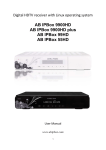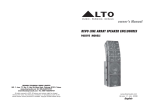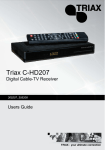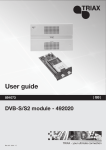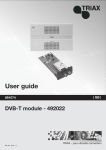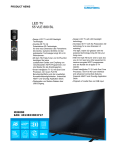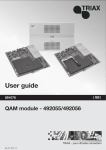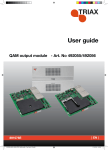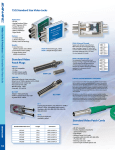Download User guide
Transcript
Contents User guide TDX Headend Unit - Art. No. 492090 891072I 1 │ EN│ Contents Contents SAFETY PRECAUTIONS ................................................................................................................................................... 4 Environment ............................................................................................................................................................... 4 Power supply .............................................................................................................................................................. 4 Weight ........................................................................................................................................................................ 4 Earth ........................................................................................................................................................................... 4 Disposal ...................................................................................................................................................................... 4 INTRODUCTION................................................................................................................................................................. 5 BOX CONTENTS ................................................................................................................................................................. 5 HEADEND OVERVIEW ...................................................................................................................................................... 6 EXTERIOR ......................................................................................................................................................................... 6 INTERIOR .......................................................................................................................................................................... 7 SINGLE HEADEND INSTALLATION ................................................................................................................................ 8 MOUNTING........................................................................................................................................................................ 8 VENTILATION REQUIREMENTS ............................................................................................................................................ 8 POWER/EARTH ................................................................................................................................................................. 9 ID SWITCH ........................................................................................................................................................................ 9 MULTI HEADEND INSTALLATION ................................................................................................................................. 10 VENTILATION REQUIREMENTS .......................................................................................................................................... 10 Horizontal installation ............................................................................................................................................... 10 Vertical installation ................................................................................................................................................... 10 CONNECTING UNITS – DIRECT CONNECTION ..................................................................................................................... 11 1xMain – 1xSub ........................................................................................................................................................ 11 1xMain – 2xSub ........................................................................................................................................................ 12 RF OUTPUT .................................................................................................................................................................... 13 POWER........................................................................................................................................................................... 13 CONNECTING UNITS – SWITCH CONNECTION..................................................................................................................... 13 MULTI HEADEND INSTALLATION – FIBER OPTIC .................................................................................................................. 14 RESETTING IP ADDRESS .................................................................................................................................................. 14 INPUT MODULES .............................................................................................................................................................. 15 Input module types ................................................................................................................................................... 15 Inserting input modules ............................................................................................................................................ 16 Attaching cables ....................................................................................................................................................... 16 Looping cables ......................................................................................................................................................... 17 Removing input modules .......................................................................................................................................... 17 Moving input modules .............................................................................................................................................. 17 OUTPUT MODULES .......................................................................................................................................................... 18 Output module types ................................................................................................................................................ 18 Inserting output module ............................................................................................................................................ 19 Removing output module ......................................................................................................................................... 19 Auxiliary Modules ..................................................................................................................................................... 19 Module status - LED ................................................................................................................................................. 19 SYSTEM MONITORING ................................................................................................................................................... 20 LEDS ............................................................................................................................................................................. 20 2 Contents SERVICE TOOL ............................................................................................................................................................... 23 SYSTEM REQUIREMENTS ................................................................................................................................................. 23 Computer minimum requirements ............................................................................................................................ 23 Static IP address ...................................................................................................................................................... 23 Physical connection to headend............................................................................................................................... 23 Starting Service tool ................................................................................................................................................. 24 OVERVIEW ...................................................................................................................................................................... 25 ADMINISTRATION ........................................................................................................................................................... 27 LANGUAGE ..................................................................................................................................................................... 27 LOCATION ....................................................................................................................................................................... 28 SECURITY ....................................................................................................................................................................... 30 LICENCES ....................................................................................................................................................................... 31 IP ADDRESSES ................................................................................................................................................................ 32 SNMP SETTINGS ............................................................................................................................................................ 35 REBOOTING .................................................................................................................................................................... 36 VIEWING SYSTEM LOG ..................................................................................................................................................... 37 FIRMWARE ...................................................................................................................................................................... 39 Updating ................................................................................................................................................................... 39 Cleaning up .............................................................................................................................................................. 42 SYSTEM INFORMATION ................................................................................................................................................. 43 VIEWING SYSTEM INFORMATION ....................................................................................................................................... 43 DUPLICATED PIDS .......................................................................................................................................................... 44 MANAGING CONFIGURATION FILES ........................................................................................................................... 45 CREATING ...................................................................................................................................................................... 45 ACTIVATING .................................................................................................................................................................... 45 DELETING ....................................................................................................................................................................... 45 SAVING........................................................................................................................................................................... 45 UPLOADING .................................................................................................................................................................... 46 IP INPUT CONFIGURATIONS ......................................................................................................................................... 48 CREATING ...................................................................................................................................................................... 49 MODIFYING ..................................................................................................................................................................... 53 DELETING ....................................................................................................................................................................... 53 IP OUTPUT CONFIGURATIONS ..................................................................................................................................... 54 CREATING ...................................................................................................................................................................... 54 License limitations .................................................................................................................................................... 57 MODIFYING ..................................................................................................................................................................... 57 DELETING ....................................................................................................................................................................... 57 EIT/EPG OUTPUT ............................................................................................................................................................ 58 EIT – EVERY IP SERVICE ................................................................................................................................................. 58 EIT – BARKER CHANNEL .................................................................................................................................................. 59 SNMP TRAPS ................................................................................................................................................................... 61 3 Safety Safety Precautions Environment Operating temperature -10 C to +50 C. Storage temperature -20 C to + 70 C. Max. Operating humidity 80% (RH). Max. Storage humidity 90% (RH). Power supply The input voltage must be 190-264 VAC. ~ 45/65 Hz / 280 W (Max). Use only power connections installed by professionals. Weight Minimum weight 10.5 kg Maximum weight 13.8 kg* Earth Disposal Headend units must be correctly earthed according to applicable national regulations. This product may not be disposed of with general household waste. Follow applicable national legislation when disposing of this product. 4 Headend Overview Introduction The TDX cabinet is designed to accommodate up to 16 input modules and 6 quad output modules. Up to three TDX headends can be combined as one system of up to 48 input muxes and 72 output channels. The TDX headend system accommodates up to 490 services. All incoming signals from input modules initially arrive in the TDX service-pool, where conversion to defined output signals occurs, after which the converted signals are fed to output modules. Box contents TDX headend unit, 1 x TDX Key 775310 2 x Mounting brackets 775285 4 screws (M4 x 8 hexagon ISO 7380) 840200) 1 x Torx® key (2.5 mm) 848603 1 x Power cord User guide. 5 Headend Overview Headend overview Exterior C C A E D B A Input module area B Output module area C Mounting brackets D Lock E Headend status LEDs 6 Headend Overview Interior C B A D E Input slots (16 in total) B Extractor fans C Earth terminal D Power input E RF output A Distributes the RF channels from the output modules using an F-connector. K F A G H F RF test point of output (-20 dB). N J Test point -20 dB G Configuration port Ethernet configuration port for setting up the headend unit. H AUX 1 & 2 Distributes services from IP output modules. L M L J Link 1 & 2 Connects the main unit with subunits 1 and 2. Can also be used in connection with IP input and output. K ID switch Switch for setting the ID of the main unit and the two subunits. M Slot 1 & 2 for auxiliary boards Auxiliary boards are used in connection with IP output modules. N Secure Digital (SD) card Memory card for storage of the system configuration (behind panel). 7 L Output slots (6 in total) Headend Installation Single headend installation Mounting The headend can be mounted either on a system rack or directly onto a wall. Rack installation Wall installation 1. Attach the mounting brackets to the headend with the supplied screws. Installation Bracket position Rack At the front of a headend. Wall At the rear of a headend. 2. Attach the headend to the wall or onto a system rack. Ventilation requirements 1. Ensure that min. 10cm ventilation space is available on both sides and the front of the headend. 2. Insert the key into the headend. 3. Open the door. 4. Lift the door off its hinges (optional). 5. Remove the top cover (optional). 8 Headend Installation Power/Earth 1. Connect an earth cable to the Earth terminal. 2. Attach the other end of the earth cable to an approved „earth‟ connection point. 3. Insert the supplied cable into the Power Input port. ID switch Confirm that the ID Switch is set to "0". 9 Headend Installation Multi headend installation Up to three headends can be combined to further increase the number of services provided. The headends are physically installed as per installation of single headend, i.e. by using the supplied brackets described above. Ensure that the following ventilation requirements are met: Ventilation requirements Horizontal installation Min. 20cm ventilation space must be available between headends. Min. 10cm ventilation space must be available outside the end headends. Min. 10cm ventilation space must be available from the front of each headend. 10cm ventilation space must be available on both sides of each headend. 10cm ventilation space must be available from the front of each headend. Vertical installation 10 Headend Installation Connecting units – Direct connection Note that direct connection hardware configurations require the Connection type field in the service tool‟s Admin/IP Settings/Setup window to be set to „Direct‟. 1xMain – 1xSub ID Main Unit Link1 Link2 3 ID Link1 Subunit Link2 1 1. Insert SFP copper transceivers into the “Link 1“sockets on the main headend and subunit headend. 2. Route a RJ45 Cat5e or better cable from the "Link 1" socket on the main unit to the "Link 1" socket on subunit 1. 3. Set the "ID switch" on the main headend and subunit headend to the following: Main unit = "3" Subunit = "1" 11 Headend Installation 1xMain – 2xSub ID Main Unit Link1 Link2 3 Subunit 1 Link1 Link2 1 Subunit 2 Link1 Link2 ID ID 2 1. Insert SFP copper transceivers into the “Link 1“ and “Link 2” sockets on the main headend and subunit headends. 2. Route a RJ45 Cat5e or better cable from the "Link 1" socket on the main unit to the "Link 1" socket on subunit 1. 3. Route a RJ45 Cat5e or better cable from the "Link 2" socket on the main unit to the "Link 1" socket on subunit 2. 4. Route a RJ45 Cat5e or better cable between the “Link 2” sockets on both subunits. 5. Set the "ID switch" on the main headend and subunit headends to the following: Main unit = "3" Subunit 1 = "1" Subunit 2 = "2" 12 Headend Installation RF output Power 1. Connect each headend unit to an approved „earth‟ connection point. Connect each headend unit to a combiner using RF cables from the RF output socket to the combiner. 2. Provide power to each headend unit with the supplied power lead. Connecting units – Switch connection Note that headend units connected using a network switch require the Connection type field in the service tool‟s Admin /IP Settings /Setup window to be set to Switch. Triax recommends that a network switch is used for connecting the main and subunits even if IP services are not currently supported. The network switch used must support IGMP ver. 2 and contain a sufficient number of ports to connect to the Link sockets on the main and subunits. 1. Insert SFP copper transceivers into the “Link 1“ and “Link 2” sockets on the main headend and subunit headend(s). 2. Route a RJ45 Cat5e or better cable from the "Link 1" socket on the main unit and subunit(s) to the network switch. 3. Route a RJ45 Cat5e or better cable from the "Link 2" socket on the main unit and subunit(s) to the network switch. 4. Set the "ID switch" on the main headend and subunit headends to the following: Main unit = "3" Subunit 1 to "1" Subunit 2 (if present) to "2" 5. Connect the network switch to the IP network. 13 Headend Installation Multi headend installation – Fiber optic Fiber-optic cables must be used to connect the main headend unit to one or two subunits over distances greater than 100m. The following SFP fibre-optic transceivers must be used in the Link sockets: Resetting IP address Triax Art. Type Data rate Reach Application 492087 Fiber (850nm) (LC) 1000Mbps 550m 492088 Fiber (1310nm) (LC 1000Mbps 2km Gigabit Ethernet Gigabit Ethernet The IP address of a headend unit can be returned to the factory default address by using the ID switch. 1. Turn off the power to the main unit. 2. Set the ID switch on the main unit to "7". 3. Turn on the power. The four LEDs flash red and yellow until the process of resetting the IP address has been completed. The LEDs show green-constant if the reset process was successful. 1. Turn off the power to the main unit. 2. Set the ID switch on the main unit back to the initial setting. 3. Turn on the power to the main unit. The IP address has been reset to the factory default. 14 Input Modules Input modules 16 input modules can be installed per headend unit. Hot swap technology is used in the headend, meaning that modules can be inserted/removed/moved when the headend is in operation. Input module types Each input module is identified through the use of a specifically coloured label. The label also indicates the module type‟s name and associated item number. The remainder of the label is used for noting post-installation module information. Another label containing a barcode and serial number is located on the underside of the input module. Name DVB-C input module Item number(s) 492024 Label colour Crimson Name HDMI input module Item number(s) 492030 Label colour Orange Name A/V input module Item number(s) 492080 Label colour Yellow Name DVB-S/DVB-S2 input module Item number(s) 492020 Label colour Light blue Name DVB-T/DVB-T2 input modules Item number(s) 492022, 492023 Label colour Purple 15 Input Modules Inserting input modules 1. Prize the protective cover away from an available input slot. 2. Retain the protective cover. Note: Any available input slot can be used. 3. Push the input module into the input slot until the input module is locked in position. 4. Note details for the input module on the label (optional). 5. Note details for the input module on the label located inside of the door (optional). 6. Continue inserting all additional input modules. Attaching cables Signal cables can be attached when all input modules have been installed. 1. Route the cables either through the cable openings on the top or on the sides of the headend. 2. Attach the signal cables to the „IN‟ connector on the input module. 16 Input Modules Note: Ensure that enough cable is available for relocating input modules to alternate input slots at a later date. Looping cables DVB-S/S2 signals can be looped between input modules: 1. Attach the signal cable to the IN port on one DVB-S/S2 input module. 2. Attach a loop cable to the OUT port on the same DVB-S/S2 input module. 3. Attach the other end of the loop cable to the IN port on another DVB-S/S2 input module.* Removing input modules Input modules are removed from the headend by: 1. Remove the signal cable from the module. 2. Prize the module out of the headend with a flathead screwdriver. 3. Pull the module out of the headend. Note: Modules can be removed while the headend is in operation. Moving input modules 1. Prize the module out of the headend with a flathead screwdriver. 2. Pull the module out of the headend. 3. Insert the module in a new input slot. Note: Modules can be moved while the headend is in operation. 17 Output Modules Output modules Six output modules, each consisting of four RF channels can be installed in a headend unit. Hot Flash technology is used in the headend, meaning that output modules can be inserted/removed/moved while the headend is running. Output module types Each output module is identified through use of a specifically coloured label. The label also indicates the module type‟s name and associated item number. The remainder of the label is used for noting postinstallation module information. Another label containing a barcode and serial number is located on the underside of the output module. Name QAM FTA/CI output module Item number(s) 492055/492056 Label colour Purple Name PAL FTA/CI output module Item number(s) 492050/492051/492052/492053 Label colour Green Name COFDM FTA/CI output module Item number(s) 492060/492061 Label colour Orange Name 2xCI Slots output module Item number(s) 492070 Label colour Black Note: Some output modules also contain slots for two CAM modules 18 Output Modules Inserting output module Depending on where you want to insert the output module push the extractor fan to the opposite side. 1. Insert smart cards (if relevant). Insert the service provider‟s smartcard into the CA module. Insert the CA module into either of the available slots in the output module. 2. Push the output module into an available output slot. 3. Press until the output module is locked into position. 4. Continue inserting all additional output modules. 5. Note details about the output module on the label (optional). 6. Note details about the output module on the label located on the inside of the door (optional). 7. Return the extractor fan to the centre of the output area. Removing output module 1. Release the lock mechanism on the module to be removed. 2. Extract the module from the headend. 3. Return the extractor fan to the centre of the output area. Auxiliary Modules Two slots are present in the middle of the output section for installation of auxiliary modules. For details refer to products that use auxiliary boards. Module status - LED Each input module has an LED on the front to indicate its current status when the headend is powered. Green - flashing The module is yet to be configured yet. Green No errors, and the tuner is locked to the frequency. Red Error, and the tuner is not locked to the frequency. No colour Module is not powered. Input module software updates are also displayed on the LED when the modules are updating. Orange Booting. Temporary off Initiation of the software update. Temporary green Every time the module receives a valid data package. Repeated until the update is completed without errors. Red Software update failed. 19 System Monitoring System Monitoring LEDs Four LEDs are placed at the top of the output section of each headend unit, and provide information on the state of the headend and subunits (if present). The four LEDs are named (from left to right): System Status Tuner Status Unit Link 1 Unit Link 2 The LEDs can be green - constant, green – flashing, red, or no colour is displayed. The message being indicated are different for each LED. Headend type/usage LED Name Colour Message Standalone System Status Green – constant Power is on and the headend is operational. Green – flashing The headend is booting up. Red An error has been detected in the headend, which must be investigated. Green – constant The input module tuners are locked. Red One or more Input module tuners are not locked. Tuner Status Unit Link 1 Not used Unit Link 2 Not used Headend type/usage LED Name Colour Message Main Unit in multi-unit installation System Status Green – constant Power is on and the headend is operational. Green – flashing The headend is booting up. Red An error has been detected in the headend, which must be investigated. Green – constant The input module tuners are locked. Red One or more Input module tuners are not locked. Green – constant The subunit is connected to the main unit. Red There is a problem with the connection to the subunit. No colour No subunit is connected to the main unit. Green – constant The subunit is connected to the main unit. Red There is a problem with the connection to the subunit. No colour No subunit is connected to the main unit. Green – constant Power is on and the headend is operational. Tuner Status Unit Link 1 Unit Link 2 Sub Unit 1 in multi-unit System Status System Monitoring installation Tuner Status Unit Link 1 Unit Link 2 Green – flashing The headend is booting up. Red An error has been detected in the headend, which must be investigated. Green – constant The input module tuners are locked. Red One or more Input module tuners are not locked. Green – constant The subunit is connected to the main unit. Red There is a problem with the connection to the subunit. No colour No subunit is connected to the main unit. Green – constant The subunit is connected to the main unit. Red There is a problem with the connection to the subunit. No colour No subunit is connected to the main unit. Headend type/usage LED Name Colour Message Main Unit in multi-unit installation System Status Green – constant Power is on and the headend is operational. Green – flashing The headend is booting up. Red An error has been detected in the headend, which must be investigated. Green – constant The input module tuners are locked. Red One or more Input module tuners are not locked. Green – constant The subunit is connected to the main unit. Red There is a problem with the connection to the subunit. No colour No subunit is connected to the main unit. Green – constant The subunit is connected to the main unit. Red There is a problem with the connection to the subunit. No colour No subunit is connected to the main unit. Green – constant Power is on and the headend is operational. Green – flashing The headend is booting up. Red An error has been detected in the headend, which must be investigated. Green – constant The input module tuners are locked. Red One or more Input module tuners are not locked. Green – constant The subunit is connected to the main unit. Tuner Status Unit Link 1 Unit Link 2 Sub Unit 1 in multi-unit installation System Status Tuner Status Unit Link 1 21 System Monitoring Unit Link 2 Sub Unit 2 in multi-unit installation System Status Tuner Status Unit Link 1 Unit Link 2 Red There is a problem with the connection to the subunit. No colour No subunit is connected to the main unit. Green – constant The subunit is connected to the main unit. Red There is a problem with the connection to the subunit. No colour No subunit is connected to the main unit. Green – constant Power is on and the headend is operational. Green – flashing The headend is booting up. Red An error has been detected in the headend, which must be investigated. Green – constant The input module tuners are locked. Red One or more Input module tuners are not locked. Green – constant The subunit is connected to the main unit. Red There is a problem with the connection to the subunit. No colour No subunit is connected to the main unit. Green – constant The subunit is connected to the main unit. Red There is a problem with the connection to the subunit. No colour No subunit is connected to the main unit. 22 Service Tool Service tool The headend needs to be configured before it can be used. System requirements Computer minimum requirements Static IP address A computer meeting the following minimum requirements is required for configuring the headend. Operating system: Windows XP or above Browser: Windows Internet Explorer version 6.0 or equivalent Additional software: Microsoft© Silverlight Runtime version 3.0 or above A static address must be used on the computer you use to configure the headend. Refer to the computer‟s operating software documentation for assistance on using static IP addresses. Physical connection to headend Connect a Cat5e shielded cable or better between the computer‟s network port and the configuration port on the headend. 23 Service Tool Starting Service tool 1. Open a web browser window. 2. Enter ‘http://192.168.0.100‟ in the web address field. 3. Press Enter. 4. Enter the password. 5. Press the Log in button. Note: Password = „triax1234’ when the service tool is opened on each headend for the first time. The Keep me logged in checkbox overrides the system‟s automatic time out function, which is activated after 20 minute‟s inactivity. 24 General Settings Administration Overview Communication icon Tabs Misc. Buttons System icons Configuration buttons Communication icon System icons Indicates whether the service tool is communicating correctly with the headend unit. Green The service tool and headend are communicating correctly. Red The service tool and headend are NOT communicating correctly. Indicates whether the headend unit is functioning correctly. Green The headend unit is functioning correctly. Red The headend unit is NOT functioning correctly. 25 General Settings Administration Tabs Misc. Buttons Accesses the various tabs used to configure the headend‟s input and output modules. System The service tool‟s „home‟ window. Provides system overview information and configuration activation/control. Input Tab for configuring input modules and services. CA Modules Tab for configuring CI modules and CA cards. Refer to output module manuals for information. Output Network Tab for configuring output modules and services. Channel List Tab for viewing available channels, refer to input module manuals for information. Apply Stores configuration settings on the SD card located in the headend. Button colour Red There are changes that have not been stored on the headend‟s SD card. Grey All changes are stored on the headend‟s SD card. Log In/Out Service tool access control. Admin.- Opens the settings for service tool window, where language, location, time zone, and initial IP addresses are specified. 26 General Settings Administration Administration The system language, locale, and time zone need to be specified on each headend unit. It is also necessary to specify IP addresses for headends which are located on a distribution network. Language 1. Press the Admin button at the top right-hand corner of the System window. 2. Open the Current language drop-down list. 3. Select the desired language. 4. Press the OK button. 27 General Settings Administration Location 1. Press the Admin button at the top right-hand corner of the System window. 2. Expand the Country settings area. 3. Open the Current location drop-down list. 4. Select the country where the headend is located. 5. Press the OK button. 28 General Settings Administration Time zone 1. Press the Admin button at the top right-hand corner of the System window. 2. Expand the Time zone settings area. 3. Open the Input module (Main unit) drop-down list. 4. Select the input module that is to be used for setting the headend‟s system date/time/time zone. 5. Press the OK button. 29 General Settings Administration Security 1. Press the Admin button at the top right-hand corner of the System window. 2. Expand the Password settings area. 3. Specify the current password in the Old password field. („triax1234’) if the service tool is being used for the first time. 4. Specify a new password in the New password field. 5. Re-specify the new password in the Confirm password field. 6. Press the OK button. 30 General Settings Administration Licences Licenses handle particular services, e.g. IP input and/or IP output or SNMP functionality. When you have purchased licences they need to be activated in the headend system. 1. Press the Admin button at the top right-hand corner of the System window. 2. Expand the Licence handling area. 3. Contact Triax Sales and provide the contents of the serial number and unique ID fields. 4. Enter the code provided by Triax Sales into the Activation key field. 5. Press the Activate button. 6. Press the OK button. Note: Clicking the Activate button accesses the available licence(s), the TDX unique ID changes, the activation key is deleted, and the activated licenses are listed in the pane. Additional licenses are purchased by contacting Triax and providing the serial number and unique ID. A new activation key will then be provided for accessing the additional licences. 31 General Settings Administration IP addresses It may be necessary to specify specific IP addresses for the headend to avoid network IP address conflicts. Note: Headend IP addresses can be reset to factory default settings if required. This is done via the ID switch located on the headend unit(s). 1. Press the Admin button at the top right-hand corner of the System window. 2. Expand the IP settings area. 3. Specify the headend‟s IP address, subnet mask and default gateway in the corresponding fields. Next step is only relevant where Main and sub units are connected to the network via a Gigabit network switch. 4. Press the Enter Setup button. 32 General Settings Administration The IP Settings window is used to specify unique IP addresses and subnet masks used by the Link 1 and Link 2 sockets on the main and sub units. This provides additional functionality to avoid IP address conflicts. 1. Select the Switch radio button. 2. Specify unique IP addresses and subnet mask details for the main and subunits in the corresponding fields. 3. Press the OK button. Note: The AUX 1, AUX 2 and associated IP Address and Subnet mask fields are used in connection with the IP output module. Remaining steps are valid for all multi-unit installations. The 512 IP addresses used by the headend(s) must not conflict with any of the IP addresses used either within the network or for services. 1. Enter the first of the 512 IP addresses used for internal purposes in the Start field. 2. Press the OK button when all changes have been made. 33 General Settings Administration A message is displayed if the headend needs to be rebooted due to IP address changes having been made. 34 General Settings Administration SNMP settings SNMP stands for “Simple Network Management Protocol”. SNMP is an Internet standard protocol that you use for exchanging management information between the equipment in a CATV network. You can use SNMP to monitor sub-headends, fibre notes and amplifiers or to check the status of the equipment. 1. Press the Admin button at the top right-hand corner of the System window. 2. Expand the SNMP settings area. 3. Specify the IP address of the computer that monitors the network, i.e. the SNMP manager. 4. Specify new SNMP port numbers if you want to change the default values in the two SNMP port fields. 5. Enter a password to access the SNMP manager in the Community string field. 6. Press the OK button. For an overview of SNMP traps, see “SNMP Traps”. 35 General Settings Administration Rebooting 1. Press the Admin button at the top of the right-hand corner of the System window. 2. Expand the System maintenance area. 3. Press the Reboot button. Note: Changes to IP addresses only take effect when the headend has been rebooted. 36 General Settings Administration Viewing system log It is possible to save log files for viewing headend actions. 1. Press the Admin button at the top of the right-hand corner of the System window. 37 General Settings Administration 2. Expand the System maintenance area. 3. Press the Save log button. 4. Press Open to view the log file in notepad. 5. Press Save to specify a file location and if required rename the log file as per normal Windows operating system procedure. 38 General Settings Administration Firmware Updating Firmware updates are available from the Triax home page, www.Triax.com. Always read the release notes to determine whether the headend would benefit from available firmware updates or not. 1. Press the Admin button at the top of the right-hand corner of the System window. 2. Expand the System maintenance area. 3. Press the Change button. The Firmware window lists the headend‟s current and previous firmware versions. 39 General Settings Administration 4. Press the Upload file button. 5. Navigate to where the update file is saved. 6. Select the file. 7. Press the Open button. The new firmware update file is listed in the Change firmware dialog. 8. Check the Active check box for the new update file. 9. Press the Set active button. 40 General Settings Administration 10. Select the Replace all radio button to update all of the headend‟s firmware, i.e. modules, system controller and user interface. (Recommended) 11. Select the Update old packages radio button to only update outdated modules. 12. Press the Start update button. Note: The Update old packages radio button should only be used in cases where the headend consists mainly of new modules, but also contains some older modules that might benefit from an update. The firmware update takes approximately 5 minutes, during which time upgrade information is displayed in the Status area. 13. Press the Restart button when the firmware update has completed. Note: Service distribution to end-users will be disrupted while the headend restarts. 41 General Settings Administration 14. Restart the internet browser when prompted. 15. Logon to the system tool and make any further changes. Cleaning up 1. Select the firmware updates to be removed from the system tool. 2. Press the Delete package button. 42 General Settings Administration System Information Viewing System information Detailed information is available on headend units: 1. Select the System tab. 2. Select the main unit or one of the subunits in the System information list area. The System information for unit window is displayed. The window contains information relating to: Any headend system errors Name and associated software version of input and output modules Note that the software versions installed on all headends, including each input/output module must be identical. 43 General Settings Administration Update the software for the entire headend installation (including input/output modules) if this is not the case. MAC addresses Current/minimum/maximum temperatures Power supply Duplicated PIDs Selecting IP services for output may result in a selection of services from an MPTS stream that uses the same PID for two or more services. It is not possible to output services with identical PIDs. If you have selected services with identical PIDs, the System icon of the headend unit that handles the output of the services with identical PIDs turns red. Click the affected unit to open the System information for unit window. The System information for unit window lists the output module(s) and channel(s) which attempt to output services with identical PIDs. To solve the problem you have to open the configuration window of the output module(s) listed in the System information for unit window, and deselect the selected IP services one by one while checking the System information for unit window until the message disappears from the window. 44 Managing Configuration Files Managing configuration files Creating 1. Select the System window. 2. Select the New button. An empty configuration file is created and listed in the configuration list area. Activating 1. Select the System tab. 2. Select the configuration that is to be actively used on the headend. 3. Press the Set active button. Deleting 1. Select the System tab. 2. Highlight the configuration file to be deleted. 3. Press the Delete button. Saving Headend configuration files can, if desired, be saved on the computer. This simplifies the process of configuring additional headends that contain the same modules. A saved configuration file can also be used on headends that do not contain exactly the same modules. It will, however, be necessary to reconfigure/delete/add the modules that differ between the initial headend and that being configured. 45 Managing Configuration Files 1. Select the System tab. 2. Press the Load from TDX button. 3. Navigate to where the configuration file is to be saved. 4. Enter a name for the configuration file. 5. Select „XML‟ in the File type field. 6. Press the Save button to save. Uploading Configuration files previously saved on a computer can be transferred to the system tool to simplify the configuration process. Any module differences will need to be manually configured. 1. Select the System tab. 46 Managing Configuration Files 2. Press the Load to TDX button. 3. Navigate to the folder where the configuration file to be uploaded is located. 4. Select the file. 5. Press the Open button. The configuration file will now be listed in the configuration list area. A number in brackets, e.g. (1), is added to the name of the new file if an identically named configuration file is already present. 47 IP Input Configurations IP Input configurations The headend system includes basic IPTV functionality which enables service delivery over a packet-switched network infrastructure. To handle IP input through the Link sockets the following requirements must be satisfied: IP multicast streaming (UDP streaming) Possibility of RTP IGMP version 2 SPTS or MPTS including PAT, PMT, CAT Important: The TDX headend system supports up to 7 TS packets per IP packet at IP inputs. The TDX headend system does not support IP fragmentation at IP inputs, which may occur if the IP packets are transmitted over a network with a Maximum Transmission Unit (MTU) less than approximately 80 + N*188 bytes, where N is the number of packets per IP packet.. Recommended settings are 7 TS packets per IP packet and a minimum MTU of 1500 bytes in the entire network path. Note: Licenses for IP input are required to be able to use the IPTV functionality in the headend. The licenses can be purchased from Triax Sales, and need to be activated, see “Activating licenses”. 48 IP Input Configurations Creating 1. Select the Input tab. 2. Select the IP inputs sub-tab. 3. Press the Setup button for the link socket that processes IP input. 4. Specify the desired IP address and associated IP port number in the corresponding fields. 5. Press the Update button. 6. Check the Selected services checkbox for one or more services to select the service(s) you want to use. 49 IP Input Configurations Important: If the IP input uses MPTS streams, then each stream can contain one or more services. An MPTS stream may use the same PID (Package ID) for two or more of the services that it contains. However, the headend system cannot output services with the same PID. To discover services with the same PID is NOT possible until you have selected the services with identical PIDs in order to output them using an output module or a Link socket. If you attempt to output services with identical PIDs: the System Status LED turns red on the unit that tries to output the IP services, the System icon of the affected headend unit turns red on the System tab in the Service Tool, the System Status LED and System icon turn red on the main unit in a multi-unit installation. See “Duplicated PIDs” for further information. 7. View the Status information area to ensure that IP data is being sourced through the Link socket. 8. Press the Submit button. The selected service is now available in the headend service pool. 9. Press the Apply button to save the new settings in the configuration. 50 IP Input Configurations Specifying EIT/EPG source One input on each link per headend can be configured to carry Event Information Table (EIT) data. 1. Specify the desired IP address and associated IP port number in the corresponding fields. 2. Check the Use as EIT input checkbox. 3. Press the Update button. 4. Check the Selected services checkbox for one or more services to select the service(s) you want to use 5. View the Status information area to ensure that IP data is being sourced through the Link socket. Press the Submit button. 51 IP Input Configurations Specifying Alternative EIT/EPG source 1. Specify the desired IP address and associated IP port number in the corresponding fields. 2. Open the Alternative EIT source drop-down list. 3. Select the EIT source to be used. 4. Press the Update button. 5. Check the Selected services checkbox for one or more services to select the service(s) you want to use 6. View the Status information area to ensure that IP data is being sourced through Link 1 or 2 on the socket. 7. Press the Submit button. 52 IP Input Configurations Modifying To modify an existing IP input configuration: 1. Press the Setup button associated with the IP input configuration. 2. Make the required modifications as when creating an IP input configuration. 3. Press the Submit button. 4. Press the Apply button when the modifications have been made. Deleting 1. Press the Delete button of the IP input to be removed. 2. Confirm that the selected IP input is to be removed. 3. Press the Apply button. 53 IP Output Configurations IP Output configurations Creating The headend system offers the following possibilities when you output IPTV services through the Link sockets. IP multicast streaming (UDP streaming) No RTP option IGMP version 2 SPTS or MPTS including SDT, PAT, PMT, CAT Packet ratio of 1 TS packet per IP packet Not possible to change service ID (SID) Note: Licenses for IP output are required to be able to use the IPTV functionality in the headend. The licenses can be purchased from Triax Sales, and need to be activated, see “Activating licenses”. 1. Select the Output tab. 2. Select the IP outputs sub-tab. 3. Press the Setup button for the link socket that will process IP output. 54 IP Output Configurations 4. Specify the desired IP address and associated IP port number in the corresponding fields. 5. Press the Services button. The Select Services window displays services from input that has entered the headend system through the same unit which contains the Link socket(s) being used for service distribution. 6. Select the services to be distributed through the link. 7. Press the OK button. Notes: Services selected for one output on a Link will not be selectable for other outputs on the same Link. Re-scrambled and/or descrambled services cannot be distributed 55 IP Output Configurations using the Link sockets. They can, however, be distributed using an IP output module and the AUX sockets. See the IP output module user guide for further information. 8. View the Status information area to see the following: The link‟s RTP status The transfer bitrate The number of license services used. The total number of purchased service licenses 9. Press the Submit button. 10. Press the Apply button. 56 IP Output Configurations License limitations The following message is displayed if more services have been selected than are permitted by the current licenses. Modifying To modify and existing IP output configurations: 1. Press the Setup button associated with the IP output configuration. 2. Make the required modifications as when creating an IP output configuration. 3. Press the Submit button on the IP output setup window. 4. Press the Apply button when the modifications have been made. Deleting 1. Press the Delete button for the IP output to be removed. 2. Confirm that the selected IP output is to be removed. 3. Press the Apply button. 57 IP Output Configurations EIT/EPG output If you want to distribute EIT information in connection with your IP output, you can choose between: distributing EIT information with every single IP service, or use a barker channel for carrying all EIT information for the IP output. The EIT barker channel can be output in two ways depending on how you distribute your IP output: EIT – every IP service IP output method Barker channel distribution method IP output is distributed through the Link sockets. EIT barker channel is output through Link 2 on the main unit IP output is distributed through an IP output module EIT barker channel is output through the AUX socket on the first IP output module in the headend system 1 Select the Network tab in the Service Tool. 58 IP Output Configurations 2. Open the EIT drop-down list. 3. Select “Full Actual – No other”. 4. Press the Submit button. A message window is displayed confirming that the configuration has been submitted. 5. Press the Apply button. EIT – barker channel 1. Select the Network tab in the Service Tool. 2. Open the EIT drop-down list. 3. Select “Barker channel”. 4. Specify the IP address for the EIT barker channel in the EIT barker IP address field. 5. Specify the associated port number in the EIT barker IP port field. 6. Press the Submit button. 59 IP Output Configurations Note: The IP address used for the barker channel must not conflict with any of the IP addresses used for service distribution. A message window is displayed confirming that the configuration has been submitted. 7. Press the Apply button. The Network window now contains a single line of information stating which unit and socket is used by the EIT barker channel. 60 SNMP traps PowerUp OID: 1.3.6.1.4.1.41359.1.1.1.1 Trap generated when the TDX will be power cycled. Login OID: 1.3.6.1.4.1.41359.1.1.1.2 Trap generated when the web configurator is logged on. Logout OID: 1.3.6.1.4.1.41359.1.1.1.3 Trap generated when the web configurator is logged out. TimeOut OID: 1.3.6.1.4.1.41359.1.1.1.4 Trap generated when the web configurator is timed out. FailedLogin OID: 1.3.6.1.4.1.41359.1.1.1.5 Trap generated when the web configurator login has failed. Restart OID: 1.3.6.1.4.1.41359.1.1.1.6 OID: 1.3.6.1.4.1.41359.1.1.1.7 Trap generated when TDX is restarted. InputError Trap generated when an input module has an error, e.g. module no longer locked to frequency, missing module etc, CIInsertion OID: 1.3.6.1.4.1.41359.1.1.1.8 Trap generated when a CI module is inserted in the TDX. CIRemoval OID 1.3.6.1.4.1.41359.1.1.1.9 Trap generated when a CI module is removed from the TDX. 61 ModuleInsertion OID 1.3.6.1.4.1.41359.1.1.1.10 Trap generated when an input or output module is inserted. ModuleRemoval OID 1.3.6.1.4.1.41359.1.1.1.11 Trap generated when an input or output module is removed. CIDescramblingError OID 1.3.6.1.4.1.41359.1.1.1.12 Trap generated when a service descrambling has an error. CICommunicationDown OID 1.3.6.1.4.1.41359.1.1.1.13 Trap generated when communication with CI module fails. VideoDecodingError OID 1.3.6.1.4.1.41359.1.1.1.14 Trap generated when video decoding of a service in a PAL output module fails. InterlinkDisconnect OID 1.3.6.1.4.1.41359.1.1.1.15 Trap generated when main unit loses connection to a subunit. ConfigurationChangeApplied OID 1.3.6.1.4.1.41359.1.1.1.16 Trap generated when the user applies changes in the web configurator. InputOK OID 1.3.6.1.4.1.41359.1.1.1.17 Trap generated when an input module error disappears, e.g. errors that can disappear are input module no longer locked to frequency, missing module etc, CIDescramblingOK OID 1.3.6.1.4.1.41359.1.1.1.18 Trap generated when a service descrambling error disappears. 62 CICommunicationUP OID 1.3.6.1.4.1.41359.1.1.1.19 Trap generated when communication with the CI module no longer fails. VideoDecodingOK OID 1.3.6.1.4.1.41359.1.1.1.20 Trap generated when a video decoding of a service in PAL output module no longer fails. InterlinkConnect OID 1.3.6.1.4.1.41359.1.1.1.21 Trap generated when a main unit is connected to a subunit 63 Manufacturer Dear Customer Should you require technical assistance in the event that your expert dealer is unable to help you, please contact us at: Triax A/S Tel.: +45 76 82 22 00 Bjørnkærvej 3 mail: [email protected] 8783 Hornsyld web: www.triax.dk Denmark DECLARATION OF CONFORMITY TRIAX confirms that the product conforms to relevant EEC harmonised standards and consequently can carry the CE-mark. Relevant harmonised standards: DE/EN 60728-2 2010, DS/EN 60728-11 2010 and DS/EN 50083-2 2006 This document is only valid with the signature of the person responsible for CE-marking by Triax Date: October 2012 01-2014 Signature: 64 your ultimate connection
































































